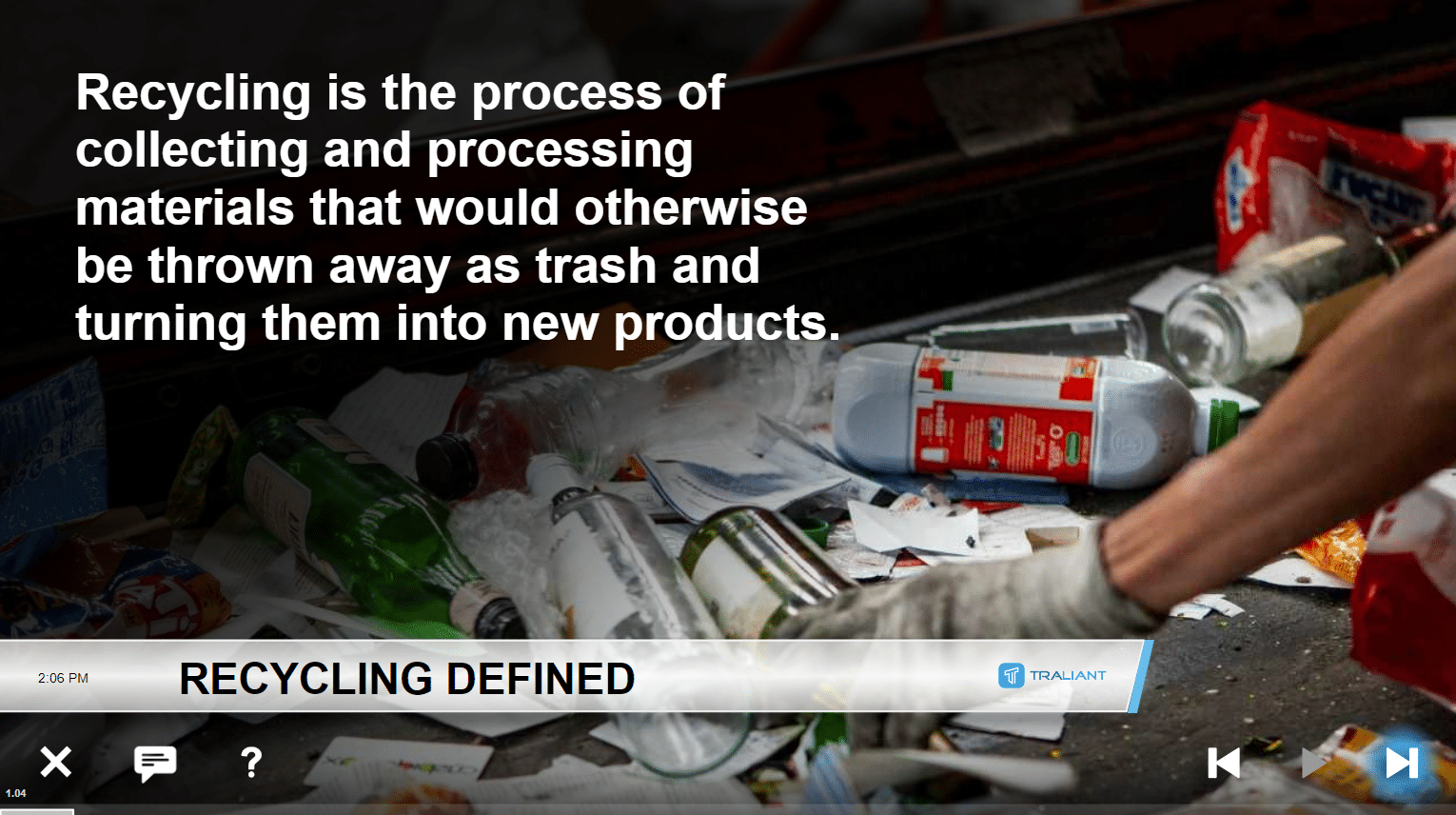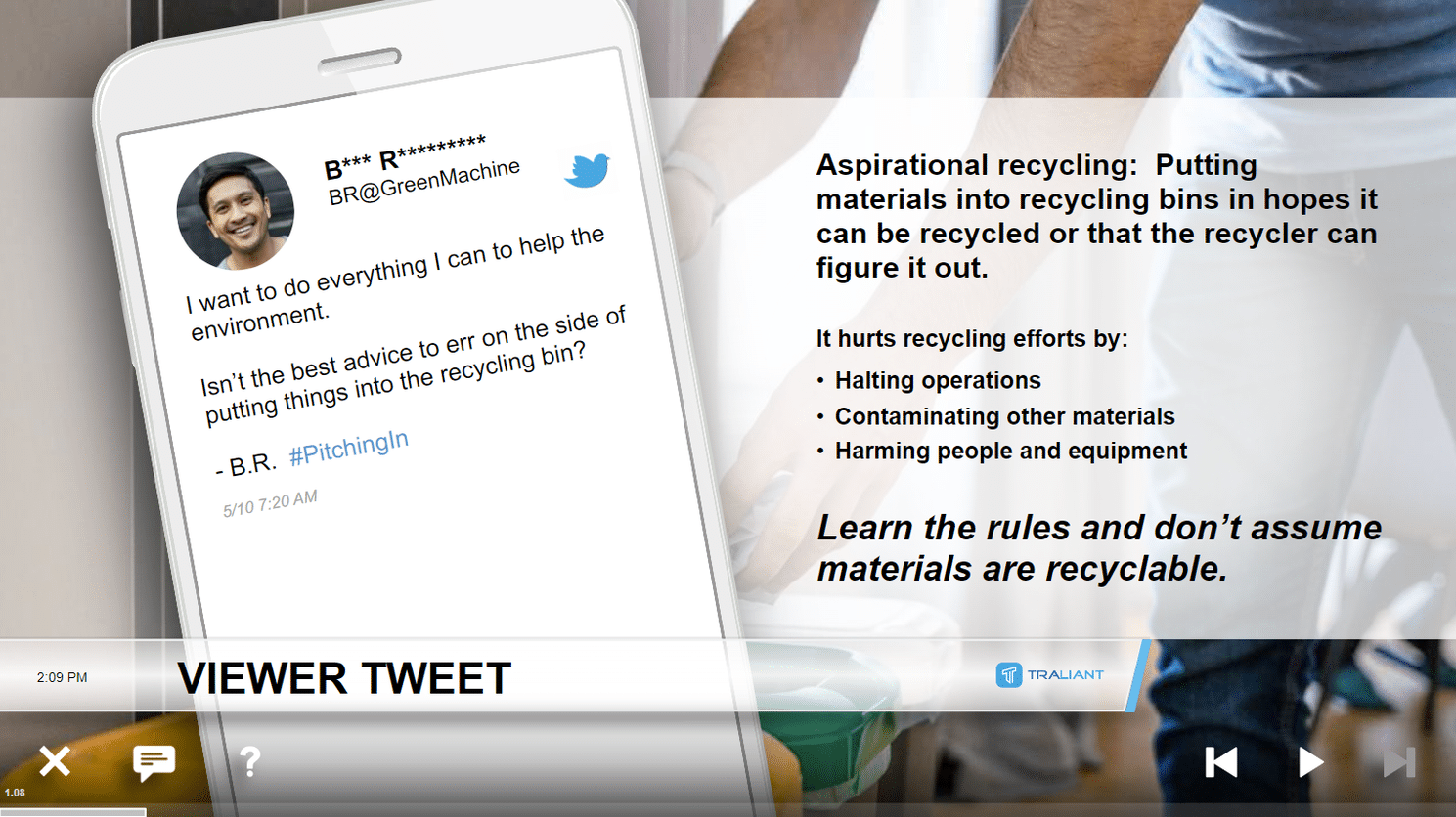
Recycling at Work
Creating a sustainable workplace enhances employee and customer engagement and ESG efforts
Course description
Recycling at Work is a 15-minute course for employees that provides an overview of recycling practices in the workplace. Interactive exercises, viewer emails and tweets address common questions and issues, challenge assumptions about what is and isn’t recyclable and provide practical ways that employees can make a difference.
ONLINE TRAINING
Recycling at Work

Recycling at Work course covers these topics and more:
- What is recycling?
- Benefits of recycling
- What should and shouldn’t go into recycling containers
- Tips for recycling paper, plastics, glass, electronics and other items
KEY FEATURES
Why you'll love our training
It’s time to embrace a new era of online training with a valued partner who will ensure seamless implementation, along with a learning experience your employees will truly enjoy.
Course administration
Traliant makes it simple to roll out training to your workplace and provide technical support directly to your employees at no additional cost.
Course customizations
Tailor courses to include your logo, relevant policies, workplace images, and more. Traliant can even customize the course with scenarios that take place in your own workplace environment.
Translations
Training is available in English, Spanish and is supported in over 100 languages.
What to consider when choosing the most effective recycling training

- Promote sustainability: Recycling is a key component of environmental sustainability. Training helps organizations to reduce their environmental impact and to conserve resources.
- Reduce waste and costs: Recycling can help to reduce the amount of waste that goes to landfills, which can lower waste disposal costs.
- Enhance the organization's reputation: Recycling programs can demonstrate a company's commitment to environmental responsibility, which can be a positive factor in attracting and retaining customers and employees.
- Empower employees: Training provides employees with the knowledge and skills they need to participate effectively in the company's recycling program.
- Strengthen your organization's commitment to sustainability: Training helps to demonstrate the company's commitment to environmental responsibility and to create a culture of sustainability.
- Increase recycling rates: When employees understand the importance of recycling and how to do it properly, recycling rates are likely to increase.
- Conserving natural resources: Recycling helps to reduce the need to extract new raw materials, such as trees, minerals, and fossil fuels.
- Saving energy: It typically takes less energy to make products from recycled materials than from virgin materials.
- Reducing pollution: Recycling helps to reduce air and water pollution associated with the manufacturing of new products.
- Protecting wildlife habitats: Recycling helps to reduce the amount of waste that goes to landfills, which can help to protect wildlife habitats.
- Paper: Office paper, newspapers, magazines, cardboard boxes.
- Plastic: Plastic bottles, containers, jugs, and bags. (It's essential to check local recycling guidelines for acceptable types of plastic.)
- Glass: Glass bottles and jars.
- Metals: Aluminum cans, steel cans, and other metal items.
- Electronics: Computers, printers, cell phones, and other electronic devices. (Electronic waste should be recycled through specialized programs.)
- Provide clear and consistent signage: Use clear and consistent signage to indicate what materials can be recycled and where to place them.
- Use convenient recycling bins: Place recycling bins in locations that are easy to access, such as near desks, break rooms, and copy machines.
- Offer training and education: Provide regular recycling training to employees to ensure they understand the program and how to participate.
- Promote the benefits: Communicate the benefits of recycling to employees to encourage their participation.






